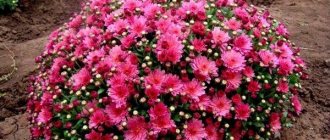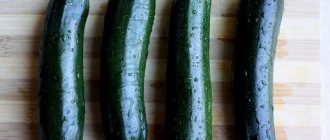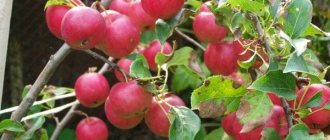Beginning gardeners want to find decorative plants that are useful and easy to care for in everyday life. Curly chlorophytum will be an excellent choice for landscaping and home decoration. After all, this plant not only serves as an unusual decoration, but also does an excellent job of cleaning and humidifying the air in the room where it grows.
Undoubted advantages in favor of this choice will also be the absolute undemandingness of the flower in care and its high resistance to diseases that affect indoor crops. It has virtually no stem and consists of a dense rosette of basal leaves. This plant is compact and has an unusual color, which makes it stand out from decorative leafy pets. Curly chlorophytum will give the room freshness and fill it with colors that are pleasing to the eye.
Characteristics of Curly Chlorophytum with photo
Chlorophytum is native to the tropical forests of Africa, Australia and South America, where in natural conditions it has more than 200 species. This is an epiphyte plant from the Asparagus family, growing on the bark of trees. One of the most unpretentious and well-cultivated is the Bonnie or Curly species. This flower differs from its counterparts in the presence of a white longitudinal stripe on the leaves, which persists regardless of external conditions.
This plant is characterized by:
- small inflorescences in the form of white stars;
- oblong curled leaves growing from the center;
- specific twisting of leaves into a spiral as the plant develops;
- the formation of children after flowering;
- the appearance of rosettes-tendrils during the growing season with further germination of leaves on them;
- can reach 50 cm in height and width, but the indoor appearance is more compact;
- The growth period is more than 10 years.
Since the plant is unpretentious in care and can grow in almost any conditions, adapting to them, it is popular both in apartments and office spaces. Being also an active air purifier, the flower is popularly nicknamed “vacuum cleaner.”
Chlorophytum
In the photo you can see that the leaves of chlorophytum have a smooth surface and variegated color.
When and how does it bloom
Blooms from spring to autumn. Hanging arrows appear from the rosette, bearing a loose panicle of small flowers. When flowering ends, daughter rosettes of leaves with aerial roots appear on the arrows.
Chlorophytum blooms.
Flowering period
Chlorophytums do not have a clearly defined period of dormancy and flowering. In favorable conditions, flower stalks appear even in winter. With a large amount of nitrogen in the soil, it may stop blooming, accumulating biomass.
Rules for caring for curly chlorophytum at home
There is an opinion that chlorophytum is suitable for all lovers of indoor greenery, because the unpretentious plant does not die even if there is no watering for a long time. But if you want to have a beautiful and living decorative foliage at home or at work, then you should follow the recommendations for caring for it.
Lighting
The ideal condition for Bonnie would be the presence of diffused light coming in the morning and evening hours, since the plant tolerates shade well and does not really like direct sunlight, but at the same time needs long daylight hours. Thanks to this, chlorophytum can be grown even in offices with artificial lighting or in rather dark corridors.
Lighting for chlorophytum
If possible, you should choose eastern or western windows for the flower; they are best suited for the lighting it requires. It is important to pay attention to the intensity of foliage coloring depending on the location of Curly Chlorophytum: the less light it receives, the paler it will look and may lose its variegated color, but will still continue to throw out new leaves and form its beautiful crown.
Temperature and humidity
Being from the tropics, the flower loves high humidity, so it is advisable to constantly spray it, this is especially true in the summer months, when the plant simply suffocates from dry air. You can use a watering can or spray bottle; “bathing” in the bathroom under the shower is also perfect. To moisten the foliage, it is better to use settled water at room temperature.
On a note!
Comfortable air temperature is +22-28°C in the warm season, and in the winter months low temperatures below +10°C should be avoided.
If a flower stands in a cold room for a long time, the green leaves begin to acquire a yellow tint and dry out at the tips. Bonnie also reacts to sudden changes in temperature; you need to limit them as much as possible by moving the flower to another place for a while in order to preserve the life and beautiful appearance of the plant.
Watering and fertilizing
Like other decorative greenery for the home, chlorophytum requires watering depending on the time of year:
- summer - abundant watering, the soil should always be moist;
- winter - moderate watering, but without drying out the soil;
- spring-autumn - watering depending on the air temperature and the place of growth, while focusing on the appearance.
You need to water the flower at the root, with not very cold, settled water. Additionally, you need to clean the foliage from dust at least once a week using a damp cloth.
A special feature of this plant is its ability to store moisture in the stems and roots, making it possible to use it during periods of drought. At home, this means that Curly Chlorophytum can go without watering for up to a month and feed on its moisture reserves during this time. This feature is convenient to use during business trips and vacations, because you don’t have to ask someone to water the greens at home or in the office.
Note!
It should be noted that without watering, the flower loses its usual attractiveness and rich color, but quickly recovers when returning to the usual watering regime.
During the period of vegetative growth, the flower actively grows greenery and requires additional feeding (usually in the summer season). In order to help the flower gain new strength, it is enough to water it twice a month with mineral fertilizers in liquid form, but universal fertilizers for indoor deciduous plants are also suitable.
You may be interested in:
Gloxinia: home care, transplantation and propagation, diseases Gloxinia is a very graceful and delicate plant. It fits perfectly into any interior. How to care for this delicate...Read more...
Diseases, pests and methods of combating them
The flower is not particularly whimsical and is quite resistant to various kinds of diseases and pests, but still from time to time it can suffer from such troubles:
- Parasites: aphids, thrips, nematodes. To get rid of them, you should use special insecticides sold in specialized stores for gardeners. Among the traditional methods, you can try spraying with a solution of water and laundry soap.
Thrips on a flower
- Drying of leaf tips. Most often caused by the presence of sodium in mineral fertilizers, in which case the type of fertilizing should be changed.
- Yellowing of the leaves is associated with rotting of the root system due to excess soil moisture. It is necessary to replant the flower, first removing the damaged roots and changing the watering system to a more optimal one. If, upon inspection of the root system, no damage was noticed, then the plant has suffered from drafts and should simply be moved to another location.
If chlorophytum is sick, then all damaged areas must be cut off. It is also useful to completely replace the soil and treat with a fungicide.
Chlorophytum, pets and children
If you have a cat, then she will probably gnaw on the long, succulent leaves of chlorophytum. This cannot be allowed - after all, the juice of the plant is conditionally poisonous for cats. These creatures usually chew the leaves of all saber-shaped plants in order to trigger a gag reflex when it becomes necessary to empty the stomach of the fur that has accumulated there. But, it is better to place the flower in places inaccessible to the animal or, in general, to abandon it in favor of others that are no less attractive, but safe for your pet.
By the way, chlorophytums are also kept farther and higher away from small children so that they do not injure their palms by grabbing the sharp saber-shaped leaf of the plant and drag it into their mouths.
We advise you to pay attention to this unpretentious but charming guest from the tropics. We are sure that you will make friends and find a common language. Chlorophytum will gladly decorate the interior of your home, and for many years, day after day, it will delight your household and guests with its unusual and attractive appearance.
Flower propagation at home
For lovers of homemade greens, it is useful to know that the Bonnie species can easily be propagated at home, and you can choose from several possible options which are more convenient.
Seeds
This type of propagation of this flower is not very popular due to the fact that the seeds do not always germinate and this complicates the process and makes the procedure lengthy. If you decide to plant chlorophytum from seeds, you should take the following steps:
- soak the seeds for a day;
- collect soil into the prepared pot and place it wet on the surface;
- cover the container with cling film and place in a warm place;
- Once every few days, remove the film and ventilate the soil, moistening it;
- wait until the young shoots emerge and a few leaves appear on them before replanting.
Chlorophytum seeds
Each sprout with several leaves can be safely transplanted into a separate container, the plant will quickly gain strength and grow into a full-fledged green decorative decoration for the house.
You may be interested in:
How to care for geraniums in winter? Many women love to grow flowers at home, because it’s not only beautiful, but there’s something to do with their free time....Read more...
Rosettes
Using rosettes is a great way to increase the number of indoor chlorophytums quite quickly and painlessly. After the flowering period has ended, new children will definitely appear, which can be safely trimmed in the required quantity for replanting.
Breeding the Bonnie variety is possible in two ways:
- trim the baby and immediately plant it in a pot with substrate;
- After cutting the rosette, place it in a container of water for some time to germinate so that small roots appear.
Propagation by rosettes
Both methods are simple and productive in the process of propagating indoor crops, and they can be used at any time of the year, which is also a definite advantage.
Dividing the bush
This technique is appropriate for adult plants that are more than two years old. To use division, you must first moisten the soil in the flowerpot well and remove the flower with roots.
Reproduction of chlorophytum by dividing the bush
After this, take a sharp garden knife and divide the root part into several parts. The damaged areas where the cut was made should be treated with charcoal and after that you can plant Bonnie pieces in different pots in a special substrate with drainage.
You may be interested in:
Sansevieria: care at home and reproduction Sansevieria, or colloquially “mother-in-law’s tongue”, “pike tail” does not require special care at home, but it is one...Read more...
Description of the plant
The height of chlorophytum at home rarely exceeds 60 cm, although in its homeland this culture can reach 1 meter . All leaves are collected in a basal rosette; they are long and narrow.
Chlorophytum roots are large, sometimes in the form of bulbs, in which moisture and nutrients accumulate. This method of survival is necessary in natural conditions.
Plants differ in color and shape of foliage. Some have white stripes, others curl, and others have wider leaf blades. Of interest to gardeners is the variety that grows children - they are arranged in a cascade on long shoots along the perimeter of the plant.
Interesting! There are many babies when the plant is watered frequently. To evaporate moisture faster, you need to increase the leaf area, so chlorophytum grows new plants on itself
How does chlorophytum bloom?
Few people have been able to organize care for chlorophytum at home (watering, wintering, replanting and propagation) so that the plant blooms. But in fact, it is capable of setting buds and blooming small white flowers with long stamens on a thick, powerful arrow.
Why doesn't chlorophytum curl?
With age, the leaves of the flower become more wavy than curly. It may lose its former splendor and originality of form. This often happens due to the fact that during the active growth phase, chlorophytum threw out too many children and they take up a lot of its strength. However, children will have curls without any problems.
It is also possible that the flower does not curl due to the fact that there is no room left in the pot for the development of the root system, and this closes the way to the full development of Bonnie. If such a problem is noticed, then you should transplant it into a larger pot, and also regularly tear off some of the foliage and children so that there is enough moisture in the trunks for all life processes and the flower again acquires the desired shape.
Important!
Young plants of this species are more susceptible to leaf curling than adult crops.
Possible problems in cultivation and diseases
The most common problem with this shrub is its drying out. To avoid problems, the flower is regularly watered, sprayed and ventilated.
Drops buds and leaves
The situation occurs due to a lack of nutrients and microelements in the soil. It is worth reviewing the fertilizing schedule and the fertilizer compositions used.
The leaves are turning pale
This can happen from excess moisture. Also, the flower most likely does not have enough light. Depleted soil and lack of microelements often lead to pale foliage.
The tips of the leaves are drying out
This indicates that the plant is simply drying out. The earthen ball has not been watered for a long time. Additionally, it is worth paying attention to air humidity and spraying.
The lower leaves fall off
Perhaps the soil was too flooded and the process of rotting of the root system began. In this case, moisturizing should be stopped immediately.
Pests
Among the popular pests that bother chlorophytum are aphids, thrips, and scale insects. To begin with, use a soap solution; if the solution does not help, then you will have to use chemicals.
Important! Doctors do not recommend displaying a large number of flowers in the bedroom, despite their beneficial properties.
Chlorophytum curly flower close up
Beneficial properties of the indoor plant chlorophytum
The Bonnie flower will not only please the eye with its green foliage year-round, but will also benefit the home in which it is grown because it:
- an excellent air purifier that helps with dust and even fungi;
- can alleviate allergic reactions;
- humidifies the air, which is especially important on hot days;
- absorbs harmful fumes after repairs;
- has cleansing properties that improve memory;
- Helps cleanse the intestines of pets.
From a Feng Shui point of view, chlorophytum reduces the level of negative energy in a room and helps transform it into positive energy. It is also a good helper for resolving conflict situations and is recommended for use in office spaces with a large number of people and constant tension.
Types of chlorophytum
Despite the numerous types of flowers, there are only 4 popular varieties that successfully grow in Russia:
Chlorophytum curly - has the second name Chlorophytum Bonnie. Its name already describes the appearance of the plant - its leaves are short and wide, curled and have an unusual color with stripes of dark green or white. If you care for it correctly, you can enjoy small “panicles” of light-colored blooms throughout the spring and summer.
Chlorophytum crested - has a low stem from which elongated leaves extend. This is the most common species in Russia; it can be found in almost every gardener. The plant is interesting for its growth - new leaves emerge from the axils, which gradually take the positions of the old ones. This species produces white, star-shaped flowers that grow primarily on shoots.
Orange chlorophytum - the appearance of the presented plant is so interesting that it is chosen by many experienced gardeners or beginners who prefer harmony between the interior and living plants. The flower has an orange-red petiole from which dark green leaves emerge. This species has several varieties that differ from others in the rich orange hue of their leaves. They are not so easy to care for - the color can be lost if any mistake is made. For example, if there are a large number of peduncles, the leaves turn from orange to green.
Chlorophytum capis is a rare species in Russia. It differs from the others by the presence of a tuber instead of the usual ornate roots. The leaves are also of an interesting shape - they reach 3 cm in width and about 60-70 cm in length.
All types of chlorophytum, with the exception of Cape, have daughter rosettes used for propagation. They are easily separated and rooted, which will be discussed in more detail later.
Conditions for keeping chlorophytum. Video:
About the propagation of chlorophytum
In theory, there are 3 possible methods for propagating chlorophytum, but in reality only 2 are used - division and propagation by daughter bushes.
Propagation by seeds is possible - this means germinating the plant from the very beginning, which is quite labor-intensive and ineffective.
Of the planted seedlings, no more than 40% of sprouts emerge.
Reproduction by division
If chlorophytum is already mature, it can be propagated by dividing the bush. This is easy to do - you just need to remove the entire root system from the pot, which will fill the entire volume. It is better to remove the roots from moist soil, so the flower is watered several hours before the procedure.
If possible, the removed flower is divided into several copies along with a lump of earth. A knife is used for this. Additionally, rotten areas must be removed before planting. The plant is simply planted in pots and covered tightly with soil.
Reproduction by daughter bushes
The daughter bushes play a more decorative role - they hang cutely on the stem, which, if possible, begins to bloom additionally in spring or summer. To propagate by bushes, you need to do the following:
- Cut the bush from the stem with a knife. It is also recommended to remove it in the future so that it does not spoil the appearance by drying out.
- The bush is placed in water for several days - after 3-4 days the first roots will appear.
- With roots, the bush is planted in suitable soil and cared for according to the same principle as described earlier.
If the daughter bush is large, it can be immediately planted in the soil, which is immediately moistened and the plant is cared for as usual.











